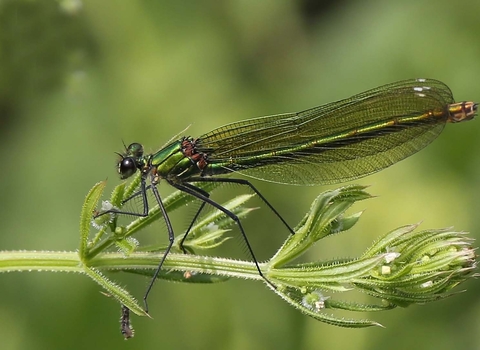
Male Banded Demoiselle ©Mark Hamblin/2020VISION

Female Banded Demoiselle ©Margaret Holland
Banded demoiselle
The Banded demoiselle can be seen flitting around slow-moving rivers, ponds and lakes. The males are metallic blue, with a distinctive dark band across their wings, and the females are a shiny green.
Enw gwyddonol
Calopteryx splendensPryd i'w gweld
May to AugustGwybodaeth am rywogaethau
Ynghylch
The Banded demoiselle is a large damselfly that lives along the edges of slow-flowing rivers and canals, still ponds and lakes, and among lush, damp vegetation. Its common name is derived from the distinctive 'fingerprint' mark on the males' wings. The only other damselfly with coloured wings is the similar-looking Beautiful demoiselle; however, this species lives on smaller, fast-flowing rivers, mainly in the west of the country. Banded Demoiselle males are very territorial, performing fluttering display flights to win over females. They are on the wing from May to August.Sut i'w hadnabod
Male Banded demoiselles are metallic blue, with broad, dark blue patches on each wing; females are metallic green with pale greenish wings. Of the UK's damselflies, only the Banded demoiselle and similar Beautiful demoiselle have coloured wings; the latter differs by displaying almost entirely dark, metallic wings. At rest, damselflies hold their wings along the length of their abdomen.Dosbarthiad
Found in England, Wales and Northern Ireland.In our area
The Banded Demoiselle is only found on the east side of Montgomeryshire, being largely restricted to the main rivers; the Severn, Vyrnwy and Banwy.
Roeddech chi yn gwybod?
Female banded demoiselles lay their eggs by injecting them into plant stems under the surface of the water. The eggs take about two weeks to hatch and the larvae take two years to develop, overwintering in the mud at the bottom of the river or pond.The Banded Demoiselle is only found on the east side of Montgomeryshire, being largely restricted to the main rivers; the Severn, Vyrnwy and Banwy.
